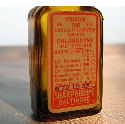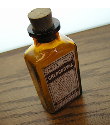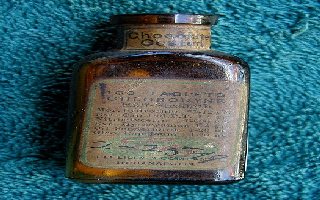Chapter 10
Chlorodyne and Cannabis in the Era of Generic Medicines
Chlorodyne and Cannabis in the Era of Generic Medicines

In today's world of exclusive patented/trade marked prescription drugs, it is difficult for the modern day reader to have a comprehension of a time when generic drugs were the rule, not the exception. According to the journal of the American Pharmaceutical Association:
"The American Pharmaceutical industry of the early 20th century was predominantly a manufacturing industry. Individual companies started by serving a geographical region with an assorted line of standard products or by championing a specific dosage form or manufacturing process. The catalogs of the larger manufacturers ran to several hundred pages, . . . . When one company brought a new product to market, it could be quickly copied and supplied by a number of other companies. Innovation was not characteristic of the industry." J.A.P.A.-Sept/Oct. 2001 pg. 657.
|
H.Wampole |
 ParkeDavis |
 SharpDohme |
 ParkeDavis |
 EliLilly |
 Teasdale |
EliLilly |
 Catalogs |
 Catalogs |
 Catalogs |
10.0 - CHLORODYNE AND Cannabis in the Era of Generic Medicines:
10.1 - An Era of Generic Medicines:In today's world of exclusive patented/trade marked prescription drugs, it is difficult for the modern day reader to have a comprehension of a time when generic drugs were the rule, not the exception. According to the journal of the American Pharmaceutical Association:
"The American Pharmaceutical industry of the early 20th century was predominantly a manufacturing industry. Individual companies started by serving a geographical region with an assorted line of standard products or by championing a specific dosage form or manufacturing process. The catalogs of the larger manufacturers ran to several hundred pages, . . . . When one company brought a new product to market, it could be quickly copied and supplied by a number of other companies. Innovation was not characteristic of the industry." J.A.P.A.-Sept/Oct. 2001 pg. 657.
10.2 - Pre-1937 Generic (Cannabis) Compound Drugs:
One cannot put enough emphases on the fact that unlike today, almost ALL ethical drugs during the mid 19th to early 20th Centuries were generic and not proprietary in nature. This meant that just about every pharmaceutical house manufactured [with some very minor chemical changes] essentially the same products.
Making reference to Cannabis, below is a VERY PARTIAL list of pre-1937 generic compound mixtures that made use of Cannabis as one of their key ingredients. [Note that this is only a VERY PARTIAL list, representing only those generic compounds observed by the author. Pure Cannabis products are discussed elswhere]
- Anodyne for Infants
- Bromide Compound
- Cannabis Indica, Arsnic & Iron
- Cannabis and Zinc Phosphide
- Cannabis Indica, Digitalis and Iron
- Cannabis Compound [containing other ingredients]
- Cannabin Compound [containing other ingredients]
- Cannabis Indica & Codeine
- Chlorodyne
- Chlor-Anodyne
- Croup (Spasmodic)
- Damiana compound (Dr. La Madrid)
- Ergotin and Cannabis comp.
- Ergotin, compound
- Hypnotic Comp
- Nerve Tonic
- Neuralgic (Brown-Sequard)
- Neuralgic (Dr. H.J. Kenyon)
- Neuralgic Improved
- Ovarian-Cannabis compound
- Phosphorus and Cannabis Indica
- Sedative (Dr. Brown)
- Sedative
- Strychnine Comp
- Zinc Phosphite, compound
10.3 - Ethical verses Patent Medicines:
Because language verbiage/usage changes from generation to generation some 19th Century concepts have today become somewhat skewed, if not out and out reverse. Given today's usage the term "patented" simply implies a drug that has some kind of patent associated with it and the word ethical doesn't seem to mean anything. But in 19th Century linguistics these two terms had a different definition:
ETHICAL DRUG: Implies a generic (commonly made) drug that was in general accepted by the medical community.Pre-1937 medical Cannabis antique collectors should simply be aware and keep in mind the differences of language usage.
PATENT MEDICINE: A secret and/or propriety drug [in many cases a Quack Medicine] to which only the propriety manufacturer knew the formula too.
10.4.1 - Chlorodyne --- The Wonder Drug of the 19th Century:
In the authors opinion, no drug best emphasizes the Generic nature of 19th, early 20th Century compound drugs better than Chlorodyne. It was manufactured by just about all pharmaceutical companies and was responsive for saving numerous lives; Probable more [again in the authors opinion] lives than any other drug until the creation of the sulfur drugs.
And although the Drug made use of Cannabis as one of its key ingredients, today Chlorodyne
10.4.2 - The origin of Chlorodyne:
The following is taken directly from a 1924 pharmaceutical catalog from Parke-Davis:
CHLOR-ANODYNE "Each fluid ounce of Chlor-Anodyne contains: Morphine hydrochloride, 2 7/8 grains; fluid extract cannabis, U. S. P., 46 minims; chloroform, 46 grains; oil peppermint, 1 1/2 minims; tincture capsicum, U. S. P., 3/4 minim; diluted hydrocyanic acid, 9 minims.It would be negligent however, not to notify the reader that this is ONLY one version of the story. There are many others and from reputable sources.
This preparation, owing to the fact that it contains morphine in more than the legally exempted proportion, is subject to the operation of the narcotic law; but, unlike other preparations in our list which have been discontinued because of the irksomeness of the law as applied to them, Chlor-Anodyne is in such demand that its discontinuance is out of the question.
The original of this formula was evolved by Dr. J. Collis Browne, of the British army in India, in 1848, as a remedy for cholera. So successful was "CHLORODYNE" (for that was the name of the original preparation) in the hands of Dr. Browne that it rapidly acquired professional favor, notwithstanding the fact that its composition was kept a profound secret. The London Board of Health in 1864 expressed its approval of the preparation as a remedy for cholera in the following language: "So strongly are we convinced of the immense value of this remedy that we cannot too forcibly urge the necessity of adopting it in all cases."
Then began the era of pharmaceutical guesses as to the formula of chlorodyne. Twenty years later more than twenty different chlorodynes were on the market. In so far as these formulae, or the majority of them, agree, they were made the basis of our open formula preparation, Chlor-Anodyne, and to this groundwork we added tincture capsicum and fluid extract cannabis for their anodyne and carminative effects.
Chlor-Anodyne is prescribed in cholera infantum, cholera morbus, diarrhea, dysentery, biliary or renal colic, neuralgia, and pain in general, particularly abdominal pain of a paroxysmal character.
It must of course be borne in mind that pain has a certain diagnostic value, and that its immediate relief may not be so important as a rational interpretation of its significance. There is no reason, however, why it should not be dealt with from both points of view.
The usual dose of Chlor-Anodyne, for an adult, is 15 minims, to be repeated in half an hour if necessary. In severe diarrhea, dysentery, cholera, or colic, it may be necessary to increase the dose to 25 or 30 minims. Dilute the dose freely with water. The solution has a very pleasing flavor. Chlor-Anodyne is supplied in 1-ounce, 4-ounce and 16 ounce bottles." --- Manual of Therapy - 1924- Parke Davis & Co. Page 147
My personnel favorite is the one which has Dr. Brown-Sequard (actually his was Dr. Sequard Brown) as the creator of Chlorodyne. This is because he was supposed to have passed away in 1850, but [allegedly] was still writing articles for medical journals all the way up into the 1880's. Not bad for a dead person, I think.
But in any case, no one is disputing that the drug came into being sometime around 1850 and that the name, Chlorodyne itself is a take-off on the two words, Cholera and Anodyne [meaning a pain killer].
10.4.3 - Chlorodyne - Saver of Lives:
Just how did Chlorodyne go about saving lives? Chlorodyne (like medical Cannabis today), is/was certainly no cure, only an effective treatment for ailments. But that was enough. Perhaps the following, which of and by itself has nothing to do with Chlorodyne best explains. Note that the letter sent to than Senator Abrahams', dealt only with medical Cannabis in today's world.
Senator Abraham:I hope that all of us can except as fact, that someone with a better immune system, who is in general over-all better health, will stand a better change of survival than a biologically weakened individual.
About two months ago, I wrote the enclosed letter to your office replying to your comments about Medical Marihuana. Since that time, I have discovered some technical errors which, for the sake of accuracy, I feel should be corrected.
". . . I stated, - "Ten thousand needless cancer deaths as a result of lack of basic access to Medical Marihuana." This statement is somewhat misleading and should read: - "Ten thousand needless or premature cancer deaths as a result of lack of basic access to Medical Marihuana."
The general theory behind this statistic is as follows:
[1] According to the American Cancer Society, despite the fact that there is a 50% recovery rate, Cancer kills one out of every four Americans. This allows us to start with a statistical base of between 550,000 (those that died) and 1,100,000 (those affected by anti-Cancer therapy).
[2] According to literature put out by the federal government's own NCI (National Cancer Institute), as many as 20% of those that died did, NOT die of Cancer BUT from the weakening effects of chemotherapy and/or massive weight loss[1].
[3] Medical Marihuana (which is safe, effective and in many cases superior to other anti-chemotherapy drugs --including Marinol[2] can and does combat the weakening effects of chemotherapy. Therefore, Medical Marihuana can increase a Cancer Victim's probability factor of surviving cancer.
I am preparing an article on how I did the math and obtained 10,000 needless or premature cancer deaths. If you want to read it, just e-mail me and I'll send it to you.
Thus Chlorodyne, just like medical Cannabis today, while not being a cure only a treatment, can/did save lives.
10.4.4 - Chlorodyne and the Opium Factor:
But despite Chlorodyne's obvious strong points, as well as the fact that it contained Cannabis as one of its key ingredients, it is for the most part ignored by today's pro-medical Cannabis community. The reason, because it also made use of another ingredient -- opium.
And here, one must be blunt, when the author, and all so many others, first notice the ingredient/word "OPIUM", the universal reaction was to stay clear, and avoid like the plague. And let's face it, given all the numerous ills, that can be traced to opium, it is only natural to come to this sort of conclusion.
While from a historical perspective, it can always be argued that when Chlorodyne when first formulated (about 1850) the medical profession really didn't know that much about the harmful side-effects of opium. [There may be some truth to that] Toward the end of its' natural life-spend, various forms of Chlorodyne "without Opium" were introduced.
However, I for one believe that this argument only belittles the point; that being that Chlorodyne saved lives. For one thing, if Chlorodyne were not a legitimate drug, than why were so many pharmaceutical houses manufacturing the drug? [see pictures] So many in fact that it can be assumed that ALL of them did.
For another, why was Chlorodyne still being manufactured up until the mid-20th Century, well after the sulfur drugs were available? In fact, after quit a bit of historical research, I am now of the opinion that it was the creation of the anti-medical marihuana laws [Cannabis being another key ingredient in Chlorodyne] that finally led to the end of to its manufacture.
10.5 - Prices:
In General Chlorodyne antique bottles [containers] follow the same rules as all other Cannabis products. Price wise; Chlorodyne bottles (with readable labels) sale for between $75 (for a quick sale) to $345.
See General Price Guide for more info on prices.
FOOTNOTES:
[1] a.k.a. starvation
[2] It is interesting to note that the very medical studies that gave Marinol [a synthetic form of Cannabis] FDA approval, themselves openly state that in some percentage of patients, Marihuana the plant will work where their own synthetic drug will NOT. Meaning that for some percentage of patients the only form of relief against Chemotherapy drugs is Cannabis and nothing else.
 Back to the Last Chapter |
 BACK TO MAIN INDEX PAGE |
 On to the Next Chapter |